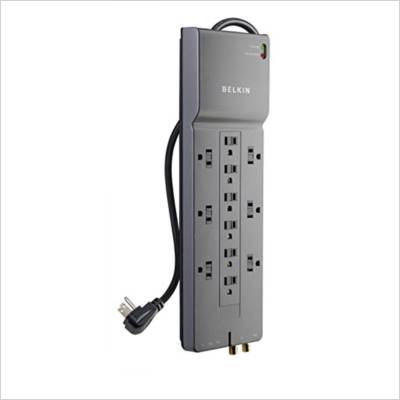Jump to Winner of Surge Protector Top 10 Rankings!
When and where do common surges happen?
Transients are sometimes the cause of broken power lines, strikes from lightning or circuit breakers tripping. They also affect the on/off cycles of large appliances and tools or the results of company’s power accidents and malfunctions of the electrical grid.
Before buying, have a closer look
A surge suppressor has its own long power cord while others are equipped with a multiple outlets connecting equipment that are plugged directly into the wall. Protect your electrical equipment by simply plugging them into a surge protector outlet. Surge diverter differs from power strip that is limited for it provides only an extension cord but with additional outlet. They are not protection against surges and line noise.
Before buying, pause a moment and consider these
Purchase the number of outlets needed after determining the number of appliances to be plugged into the surge suppressor. Most designs of protectors include transformer plugs that do not block other adjacent outlets. The joule rating of these protectors tells you the amount of energy it can absorb before it fails. The higher the number of joules, the greater protection it gives.
Protection for computers, home electronics, office equipment and workbench tools varies based on needs. Opt for a diverter that protects all inputs of your equipment including cable jacks, computer network and telephone lines.
Surge diverter is needed here
Power protector benefits all devices that are plugged into an AC outlet. Give special attention to the most vulnerable pieces of equipment with memory and circuits that are electronically sensitivity. These devices need surge protection: PCs and computer peripherals in cable boxes, DVDs, home theater components, lighting tools, monitors, office equipment, printers, routers, satellite receivers, small appliances, sound systems TVs and Video game systems.
The workings of surge protector
As voltage escalates over the accepted level, power surge protector suppresses the extra voltage preventing it from causing damage. Metal oxide varistors (MOVs) as its specific internal components easily absorb excessive voltage and divert them to ground wire thus keeping them from reaching the connected equipment. Connecting wire properly and proper grounding of AC outlets are required for surge protector to function effectively. LEDs can be included in a surge suppressor that alerts users to possible wiring problems. You’re always going to need more surge protector outlet.
Best features in surge protectors
Surge “green” protector is environmentally -friendly for its special circuit minimized consumption of energy as well as reduction of household’s utility bills. Surge protector is useful in an environment that is destructive to housing units.
The length of the extended cord & plug design determine the location of surge protector from outlet of grounded AC. If furniture flush is placed against the wall in front of the AC outlet, opt for right-angle plug surge suppressor.
Protector’s indicator light includes diagnostic LEDs confirming available power and status of protection. Check if the surge protection is still working since repeated surges of power will likely burn out the circuit’s protection.
Warranty: Be sure insurance covers replacement costs for any connected equipment damaged by a power anomaly. The insurance amount is adequate to cover all of your connected equipment.

